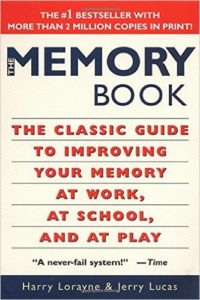There’s a lot to learn and memorize in preparation for the WELL exam. So any sort of mnemonic system you can come up with certainly helps. Here’s a tip to help with remembering a list.
Back in high school, when I was studying for the SAT’s, I came across a classic book called The Memory Book, by Harry Lorayne and Jerry Lucas.

If you have a list to remember, Lorayne and Lucas recommend that you string together a series of images, each representing an item on the list. Create a cartoon animation in your mind, and visualize each item interacting with the next item. The authors suggest that exaggerations help, i.e., picturing items as HUGE or in giant swarms helps make something memorable. The scientific literature on memory questions whether you actually need to make your images bizarre, but I still think it’s fun to imagine an outlandish cartoon.
So, applied to studying for the WELL exam, some contributors on various discussion boards have mentioned that for each of the concepts, it’s good to know where the Preconditions end and the Optimizations start. Say that you’d like to remember that the Comfort Concept has the following Preconditions:
- ADA Accessible Design Standards
- Ergonomics: Visual and Physical
- Exterior Noise Intrusion
- Internally Generated Noise
- Thermal Comfort
You might come up a cartoon animation like the following:
- Imagine a wheelchair (ADA), next to a gigantic (building-sized, 5-story high) adjustable height table.
- A hydraulic piston lifts the wheelchair 5 stories up to the top of the table, where is a computer monitor endlessly moving back and forth (Ergonomics: Visual and Physical—Visual Ergonomics, Desk Height Flexibility, Seat Flexibility).
- From the left, a window opens and the wheelchair is bombarded by a swarm of horns (Exterior Noise Intrusion).
- From the right, the wheelchair is bombarded by a swarm of noisy people and HVAC diffusers, while off to the side, a bunch of people are hunkered down, quietly working at their desks (Internally Generated Noise—Acoustic Planning, Mechanical Equipment Sounds Levels).
- A hot heat lamp, labelled “ASHRAE 55” lowers down and starts to melt the chair (Thermal Comfort).
- The heat and smoke from the chair set off a fan (Thermal Comfort Part 1: Ventilated Thermal Environment) and open a window (Thermal Comfort Part 2: Natural Thermal Environment) to help cool down the burning chair.
There you go. Now you can remember all the Preconditions for the Comfort concept. Or if this particular cartoon vignette doesn’t resonate with you, feel free to imagine your own. The effort of creating one helps with learning.
Feel free to share any fun mnemonics in the box below.
In an upcoming post, I’ll expand on this topic of study tips. Happy studying!